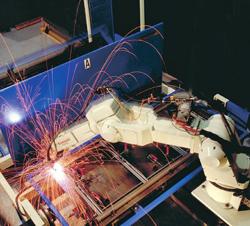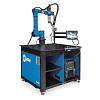North American sales manager
- FMA
- The Fabricator
- FABTECH
- Canadian Metalworking
Categories
- Additive Manufacturing
- Aluminum Welding
- Arc Welding
- Assembly and Joining
- Automation and Robotics
- Bending and Forming
- Consumables
- Cutting and Weld Prep
- Electric Vehicles
- En Español
- Finishing
- Hydroforming
- Laser Cutting
- Laser Welding
- Machining
- Manufacturing Software
- Materials Handling
- Metals/Materials
- Oxyfuel Cutting
- Plasma Cutting
- Power Tools
- Punching and Other Holemaking
- Roll Forming
- Safety
- Sawing
- Shearing
- Shop Management
- Testing and Measuring
- Tube and Pipe Fabrication
- Tube and Pipe Production
- Waterjet Cutting
Industry Directory
Webcasts
Podcasts
FAB 40
Advertise
Subscribe
Account Login
Search
Think before you integrate (robotic welding)
8 common mistakes and how to prevent them
- By Bob Rochelle
- March 1, 2010
- Article
- Automation and Robotics

Before taking the plunge with robotic welding, stop and consider these common mistakes so your experience is a successful one
The number of manufacturers investigating the benefits of flexible automation or robotic-based systems has rapidly increased in their quest to lower production costs and produce higher-quality products. Implementing robotic welding systems for the first time is generally a successful endeavor. However, potential pitfalls and common mistakes can lead to performance issues and increase operational costs.
Making yourself aware of these mistakes and the measures you should take to prevent them will contribute to a pleasant transition from labor-intensive, manual processes to the lower-cost, higher-quality automated ones in use today and into the future.
Mistake No. 1: Underestimating What You Need
The two most common mechanical ratings for industrial robots are payload and reach. Payload is the maximum weight allowed, and reach refers to the range of motion for a robotic arm.
In welding applications, the payload is not really a concern because the torch, mounting brackets, and the mechanical breakaway mounted at the end of the arm are very light.
Therefore, when you're selecting a welding robot, you must give serious consideration to its reach. The welding robot must have a range of motion large enough to reach all the weld joints and to articulate the torch into postures to weld those joints successfully. Welding robots typically are sized based on existing production specifications.
However, it's wise to consider potential changes in the part you are welding. Will it get larger? Or is it possible that you could be welding other parts on your robotic welder that may require a larger reach or heavier payload in the future? Keep in mind that the cost to purchase a robot with a large reach now may require, say, a $10,000 investment. But buying a smaller robot for $40,000 today and then having to replace it with a larger or heavier one tomorrow for, say, $50,000 doesn't make sense. And this is just the cost of the robot and does not include any costs for modifying the system to accept the larger model.
During your decision process, consider purchasing a larger robot than you need right now; you might need it down the road.
Mistake No. 2: Ignoring Peripheral Equipment
Robot technology is a mystery to new users because they are unfamiliar with it, yet the robot is not the most crucial item in the overall system design. The single most important item in the robot-based manufacturing system is the end-of-arm tooling.
Robot tooling is the mechanism mounted to the robot that actually performs the work in your system. Examples of tooling include mechanical grippers, welding torches, vacuum grippers, grinding wheels, paint sprayers, sealant dispensers, and ultrasonic horns. The robot will still move as it is programmed even if tooling performs unreliably or incorrectly, but the system will not perform as designed. As a result, your manufacturing process will suffer and you'll produce unacceptable parts.
The end-of-arm tooling or process-specific peripheral equipment is the key to a successful robotic-based system—not the robot itself—so concentrate on that.
Mistake No. 3: Failing to Plan for Disaster
Disasters do not happen in a typical robotic installation, but problems can arise that may prove detrimental to your manufacturing process. Therefore, it is imperative that you identify these issues and put a plan in place to prevent them in your automated system design.
What happens if a molten metal casting drops, a chemical spills, or a box bottom opens and its contents spill? To prevent these and other problems adequately, you may have to include items like part diverters on conveyors to maintain movement in the event of a system malfunction. You may have to employ a manual workstation as a backup; use sensors to positively verify location, action, and part integrity; provide a means to verify that the robot program selected is consistent with the fixture in place and the actual part present; and evaluate the effects of hazardous materials or conditions. Robotic systems will operate reliably and safely if all potential problems that could lead to disasters are evaluated and solutions implemented during system design and operational planning.
Mistake No. 4: Believing Robots Are Too Complicated
Robots have evolved into simple devices considering the complexity of hard automation systems. In most cases, the robot is the most reliable component in today's automated systems. Industrial robots now have a mean-time-to-failure rating that approaches 100,000 hours of operation and routine maintenance intervals specified near 10,000 hours of operation. Along with this reliability rating, typical service procedures and part replacements often require mere minutes to perform. As a result, robots are not the most complicated mechanism in automated manufacturing.
Mistake No. 5: Eliminating Crucial Weld Personnel
One of the compelling reasons to automate with robots is to utilize them for routine or repetitive tasks, allowing shops to reduce labor costs by reducing head count. In welding, the robot guides the torch while the robot controller or welding power supply controls the weld process. Due to the simplicity of this system, it is quite common to use a "parts loader" instead of a trained welder as the robotic welding system operator, which reduces the labor cost in this production cell.
But welding is a process, regardless of whether it is manual or automated. Robotic welding systems require the expertise of a trained welder to maintain process integrity and to troubleshoot welding-related issues. A trained welder is as crucial in robotic welding as he is in any other welding process.
Mistake No. 6: Using Cost as the Deciding Factor
When you make the decision to automate your welding applications, the initial cost and the return on investment (ROI) calculations are critical. It's important to understand that the cost is not the only thing you need to consider. Many of today's robotic welding systems yield an ROI within several months, so selecting the least expensive system over one that is more expensive will add only a few weeks to the ROI, but at what hidden costs?
Be sure to check that the system you are interested in has all the components included that comprise a successful system during installation and start-up. Be on the lookout for critical components that might be missing, as these items generally cost more over the life of the system in rejected parts, system downtime, or lack of process integrity.
Mistake No. 7: Expecting the Robot to Do Too Much or Too Little
An industrial robot works in conditions similar to those a blind, one-armed man does while performing the same task. For the process to be successful, the parts must be made to a quality specification and must be repeatable. Tooling and parts locators or fixtures must provide a repeatable means for the robot to positively locate and present parts for processing.
Robot systems do not tolerate randomness. Whereas humans can see imperfections, make quick decisions, and adjust behaviors to adapt to a particular situation, robots cannot. Expecting the robot alone to assume such responsibilities is expecting it to do too much. Likewise, maintaining advanced manual operations along with a robot system or operating your robot system below capacity with a duty cycle way below capability may be expecting it to do too little.
Mistake No. 8: Failing to Consider Robotic Welding Technology in Your Shop
Robotic welding systems are now a mature product and have become a key ingredient in the modern manufacturing environment. The robot itself is a commodity item, especially in the welding and fabrication industries. It may not be the right answer for your automation needs, but with recent advancements in reliability, simplicity of operation and programming, ease of path modification, standard routines, and vision-based processes, robotic technology deserves consideration in your shop.
About the Author
Bob Rochelle
28140 Lakeview Drive
Wixom, MI 48393
248-446-4211
About the Publication
subscribe now

The Welder, formerly known as Practical Welding Today, is a showcase of the real people who make the products we use and work with every day. This magazine has served the welding community in North America well for more than 20 years.
start your free subscription- Stay connected from anywhere

Easily access valuable industry resources now with full access to the digital edition of The Fabricator.

Easily access valuable industry resources now with full access to the digital edition of The Welder.

Easily access valuable industry resources now with full access to the digital edition of The Tube and Pipe Journal.
- Podcasting
- Podcast:
- The Fabricator Podcast
- Published:
- 04/30/2024
- Running Time:
- 53:00
Seth Feldman of Iowa-based Wertzbaugher Services joins The Fabricator Podcast to offer his take as a Gen Zer...
- Trending Articles
Aluminum MIG wires offer smooth feeding, reduced tangling

The role of flux in submerged arc welding performance

Three ESAB welding machines win Red Dot Awards for product design

Power source added to cobot welding system for simplified automation

Torch made for welding thin, conductive sheet metal

- Industry Events
Pipe and Tube Conference
- May 21 - 22, 2024
- Omaha, NE
World-Class Roll Forming Workshop
- June 5 - 6, 2024
- Louisville, KY
Advanced Laser Application Workshop
- June 25 - 27, 2024
- Novi, MI
Precision Press Brake Certificate Course
- July 31 - August 1, 2024
- Elgin,


























